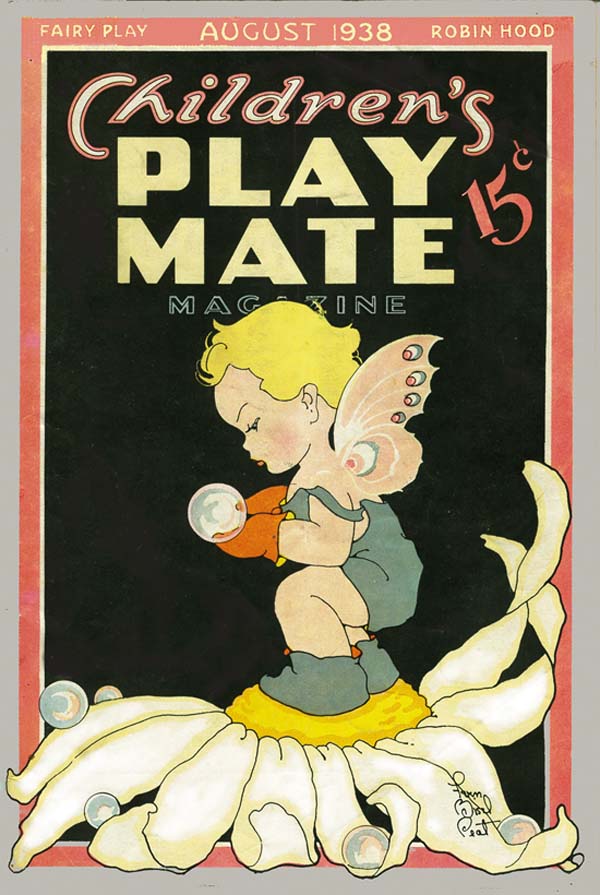Childs Play: Family-Friendly Play Mates Smack Dab In The Middle: Design Trends Of The Mid-20th Century
By Donald-Brian Johnson - January 31, 2025
Hey there, check out this months Play Mate! Now that I have your attention. Once upon a time, playmate meant something a lot different than it did to the gang at Playboy magazine. From the early 1930s onward, Childrens Play Mate was the publication getting all the publicity. Sure, there were competitors (Jack and Jill, Wee Wisdom, Highlights for Children), each with some of what Childrens Play Mate had to offer. But this digest-sized monthly, hailed as The Favorite Magazine of Boys and Girls, had it all. There were stories (The Circle-D Kid, The Mystery of the Old Barn); poems (children of Holland, with busy feet, go clomp-clomp-clomping down the street); puzzles (find 10 hidden faces in this picture!); recipes (Barbaras Favorite Frosty Grape Lemonade); projects (Make A Pumpkin Totem Pole!); and contests (Win A Pedigreed Cocker Puppy All Your Own For the Neatest and Most Interesting Letter!). There was even, in that much more trusting time, Everybodys Mail Box, with letters (and addresses) from prospective pen pals around the world. Lots more was stuffed into each issues 50-plus pages, which were geared to an enthralled readership from 4 to 14. But what primarily appeals to todays collectors, who might not be particularly interested in playing connect-the-dots, or reading about Tailspin TeenaThe Little Witch Who Couldnt Learn To Fly, is the Play Mate artwork. Most of the cover illustrations, as well as the interior art, were the work of Fern Bisel Peat, art director for Childrens Play Mate from 1933 until 1955. Her unique style captures all of the eras childhood milestones in brightly colored, whimsical drawings that serve as a time capsule of mid-20th century America. A boy and a girl sail past the pine trees on their rope-and-plank swing, another pair brave brisk spring winds to hang a birdhouse, and an angler duo peer into a pond, wondering if theyll ever have any luck on their fishing trip. And, since the magazines were monthly, Play Mate covers run right down the yearly calendar, from New Years and Valentines Day, through Halloween and Christmas. The magazines visual visionary, Fern Bisel, was born in 1893, and graduated from Ohio Wesleyan University with a degree in fine arts. In 1917, she married Frank Peat, and the pair opened an interior decorating firm, specializing in dcor items for childrens bedrooms and nurseries. In the early 1930s, the family moved to Beech Hollow Farm, near Bellville, Ohio, which became the home base for Ferns artistic endeavors. There was no doubt about who lived there: the brightly colored Beech Hollow window shutters were decorated with Ferns imaginative illustrations. In addition to her cover paintings (a duty occasionally shared with other artists), Fern was responsible for the entire look of Childrens Play Mate. That included creating the artwork for the magazines interior color pages (puzzles, cutout toys, and paper dolls), as well as the line art for its many stories, articles, and promotional ads. Bisel Peat was a versatile artist, which kept the family finances afloat during the Depression and WWII years. In addition to Ferns magazine duties, other projects included illustrating more than 60 books, among them new editions of Mother Goose and A Childs Garden of Verses. As a freelance artist, she also designed everything from childrens toy chests, wallpaper, and room dividers, to rag dolls, holiday decorations, playing cards, greeting cards, and coloring books. A notable assignment was for famed toymaker Ohio Art. There, Bisel Peat was the artistic force behind those Ohio Art tin toy favorites found in every reputable sandbox: pails, shovels, buckets, and watering cans. Originally just 15 cents, vintage copies of Childrens Play Mate remain a bargain at $10 or less. Framed, the magazines colorful covers are exuberant depictions of childhood in America. (Even better: unlike their centerfold namesakes, Ferns cover illustrations dont have a staple in the middle). Photo Associate: Hank Kuhlmann. All photos by Donald-Brian Johnson. Donald-Brian Johnson is the co-author of numerous Schiffer books on design and collectibles, including Postwar Pop, a collection of his columns. Please address inquiries to: donaldbrian@msn.com.













SHARE
PRINT